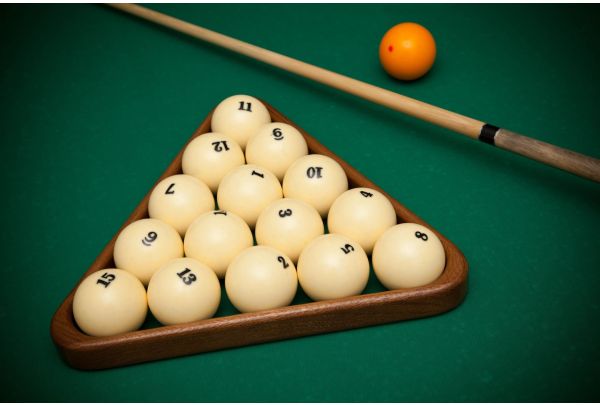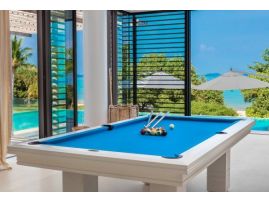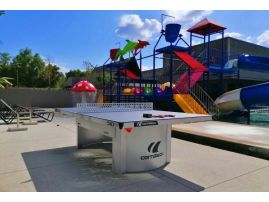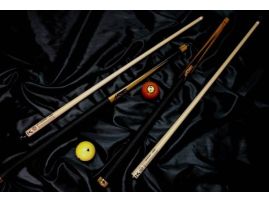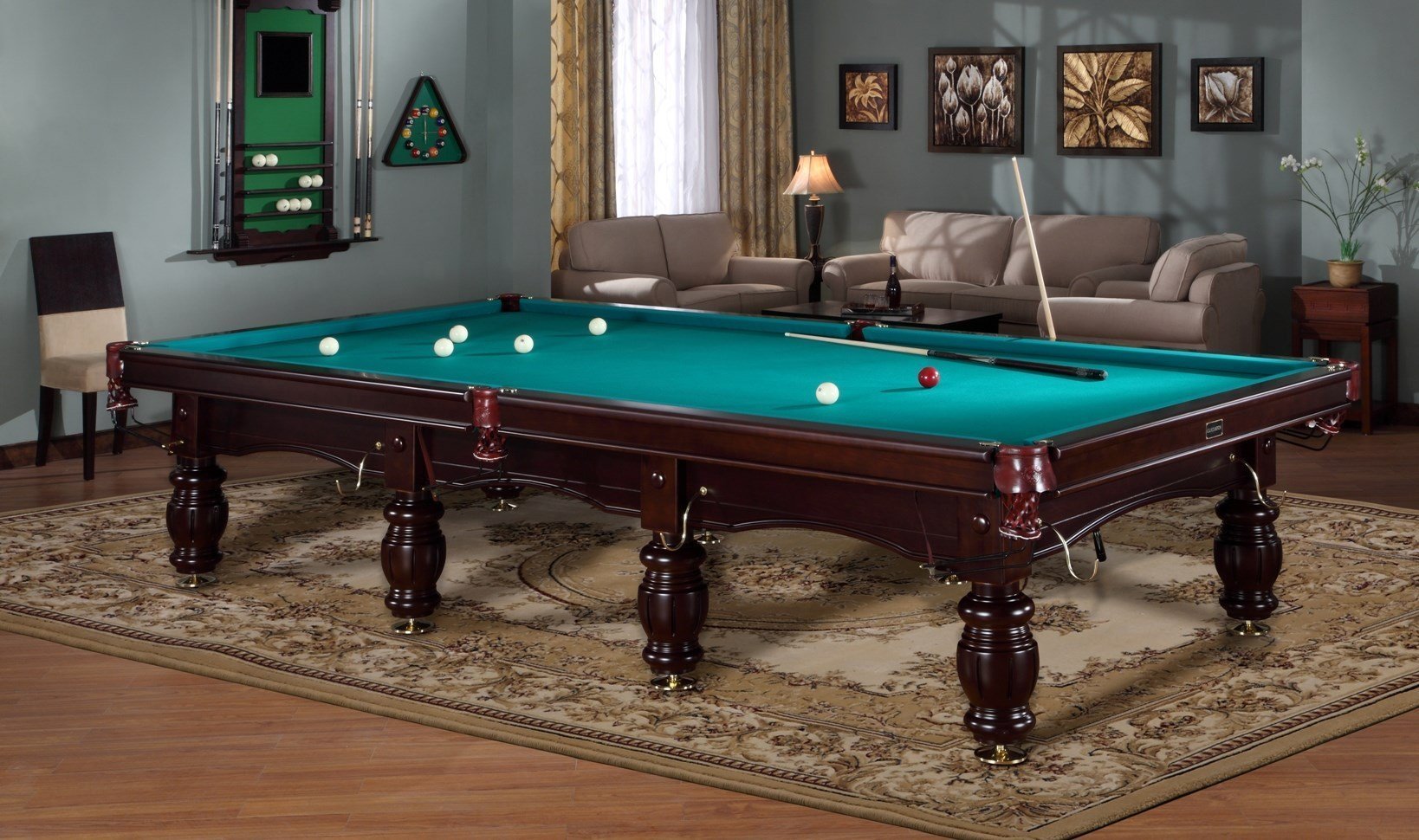
Russian pyramid, alternatively referred to as Russian billiards (ру́сский билья́рд or russky bilyard in Russian), is a variation of billiards widely enjoyed throughout Russia. This game is played on a large billiard table featuring narrow pockets.
Equipment :
- Russian Billiard Table : The standard dimensions for official Russian pyramid tournaments are 12 by 6 feet (370 cm × 180 cm), mirroring the size employed in professional snooker. However, smaller table sizes, common in various cue sports, are also present in more casual settings. Notably, the slate utilized in Russian pyramid tables is generally thinner compared to pool and snooker tables, with occasional use of a heating system
- Russian Billiard Balls : In Russian pyramid, a set comprises sixteen balls—fifteen numbered object balls and a cue ball. Unlike traditional pool, the numbered balls are predominantly white, while the cue ball stands out in either red or yellow. The official tournament size is 67 mm (2+5⁄8 in) in diameter, weighing approximately 255 g (9 oz)
- Pockets : The corner pockets in Russian pyramid are just 3 mm (approximately 3⁄16 in) wider than the diameter of the ball, demanding exceptional precision for successful pocketing. In comparison, the middle pockets provide a slightly larger margin, measuring 12–13 mm (approximately 1⁄2–3⁄4 in) wider than the ball's diameter. This design necessitates a high level of accuracy to skillfully pocket the balls.
- Russian Billiard Cue : As a result of the larger ball size in Russian pyramid, the cues employed are slightly thicker and heavier than their pool counterparts. The tip diameter for Russian pyramid cues is also wider, ranging up to 15 mm, in contrast to the 10–13 mm typically utilized in pool cues.
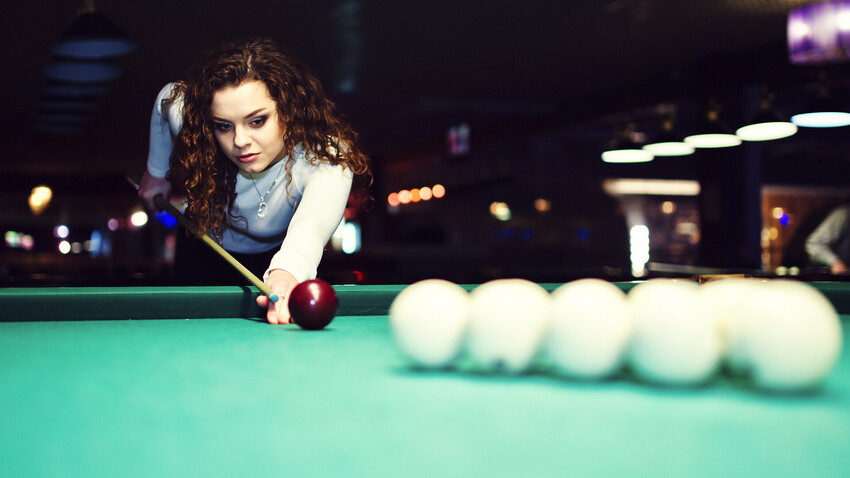
Russian pyramid encompasses various rule variations. Each game starts with a pyramid pack of fifteen numbered white balls, similar to straight pool, eight-ball, and blackball. Players have the freedom to pocket any object balls, regardless of their number, and the objective is for the first player to pocket eight or more balls to secure the frame. Unlike some other cue sports, calling shots is not a requirement in Russian pyramid. Depending on the specific game variant, certain balls may need to be in specific positions within the rack. The initial player initiates the game by breaking the rack with the cue ball from just in front of the baulk line. The most common variations are the following :
- Free pyramid (also known as American pyramid) : In Russian pyramid, any ball can serve as the cue ball. Players are allowed to pocket the ball they strike if it contacts another ball first, aiming to carom the struck ball off one or more other balls into a pocket. However, if the struck ball is pocketed without making contact with any other balls, it constitutes a foul, and the ball is placed back behind the baulk line.
- Dynamic pyramid (also known as Siberian pyramid or Nevsky pyramid) : In this particular version of Russian pyramid, only one ball serves as the cue ball. Players have the option to pocket the cue ball using a carom shot off another ball. After such a shot, the scorer must select an object ball to be removed from the table. The player is then granted ball-in-hand, allowing them to place it anywhere on the table. However, they are not permitted to pocket the ball until the next stroke; doing so before the next stroke results in a foul.
- Combined pyramid (also known as Moscow pyramid or combo pyramid) : The rules for this variation closely align with dynamic pyramid, with a notable exception: when the cue ball is pocketed, it is respotted between the head rail (bottom cushion) and the head/baulk line, but not directly on top of that line. Subsequently, until the next stroke, players are limited to pocketing balls only in the side and far-corner pockets. In pool terminology, this section of the table is commonly referred to as the "kitchen." The Russian equivalent is "дом" (dom), which translates to 'house'.
- Classical Pyramid : The rules in this variation closely resemble fifteen-ball pool. The primary objective is to accumulate a minimum of 71 points. Points are awarded for each successfully pocketed object ball, equivalent to the number marked on the ball (excluding the 1-ball, which scores 11 points). The last remaining ball on the table, irrespective of its number, is valued at 10 points. Consequently, the maximum attainable score is 130 points.
With showrooms in Bangkok, Phuket, Samui, Pattaya Thailand Pool Tables offers a large selection of Russian Pyramid Table and accessories in Thailand, contact us for more information.


